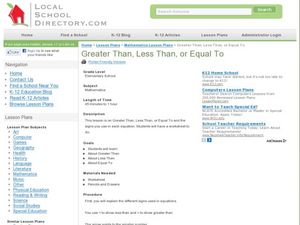Curated OER
Mental Math Skills
In this mental math worksheet, students use a number line to count backwards and forwards, add doubles, add and subtract one, and add one-digit numbers. Students solve thirty problems.
Curated OER
Greater Than, Less Than, or Equal To
This resource offers a quick lesson plan in using the symbols for greater than, less than, and equal to to compare single-digit numbers. However, the practice worksheet included has learners comparing numbers to the 100,000s, as well as...
Pennsylvania Department of Education
Adding and Subtracting Three-Digit Numbers by Jumping
Second graders use data to graph information and draw conclusions. In this instructional activity on data analysis, 2nd graders practice gathering, sorting, comparing, and graphing data. Students differentiate data that can and cannot...
Curated OER
Which Operation To Use?
In this basic addition and subtraction worksheet, 2nd graders will determine the correct operation to use. Students will study 8 problems and the given answer, deciding if the correct sign to use will represent addition or subtraction.
Curated OER
Addition and Subtraction: Basic Word Problems
For this work problem worksheet, students complete a set of 10 addition and subtraction problems. Answers are included on page. Problems are beginning level.
Primary National Strategy
Ordering and Counting
Are you in need of a 5-day unit intended to teach little learners how to count to 20? This is a well-structured complete set of lessons which employ a variety of methods to instruct learners about various ways to count from 1 to 20. They...
Curated OER
Codebreaker Math
Students solve addition and subtraction problems and decipher and write messages using a code. They read and discuss an informational fact sheet about the Navajo code talkers from World War II, and decode and re-code messages using math...
Curated OER
Where Do I Belong?
Second graders locate three-digit numbers on a number line and explain their placement in this hands-on activity based on their knowledge of numbers and place value. After the initial demo, 2nd graders stand up and get in the correct...
Curated OER
I Am The Greatest
Students work with the place value of given digits. In this place value lesson, students use a deck of number cards to find the greatest number when they draw three cards from the deck. They arrange the the digit from greatest to least.
Curated OER
Race to 50/100
Second graders practice utilizing multiple tens frames and dice to race to fifty or one hundred. They calculate tens and ones to find out how many counters they have on their grid and how many more they need to get to fifty or one...
Curated OER
Regrouping
Learners practice regrouping using the wonderful manipulative - unifix cubes. Once they have a tactile understanding of regrouping, students complete 5 worksheets containing addition problems that require regrouping. The worksheets...
Curated OER
My Dogs
Students use the properties of multiplication to solve problems. They recall the basic multiplication facts as well as write and solve problems that involve whole numbers.
Curated OER
Math Madness: A Game for Small Groups
Students work together in groups and solve math problems accurately.
Curated OER
3 dimensional shapes
Students play a bingo game to classify 3 dimensional shapes. In this 3 dimensional shapes lesson plan, students identify, describe, and classify shapes by playing a bingo game.
Curated OER
Trains
Students compare the lengths of the train through calculation. This calculation can be done by knowing the values of the rods. Students use problem solving to get the answer to the problem before them.
















